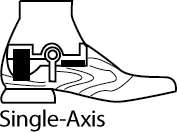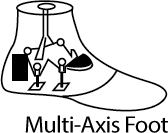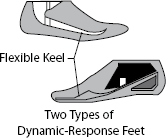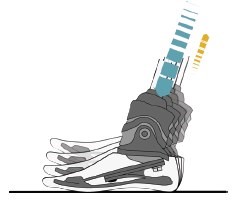Updated 08/2016 | Download PDF
Introduction
Over the past decade, technology and research have greatly expanded the functionality and aesthetics of prosthetic feet. Today, amputees have a wide array of feet from which to choose. Various models are designed for activities ranging from walking, dancing and running to cycling, golfing, swimming and even snow skiing. Heavier wood and steel materials have been replaced over the years by lightweight plastics, metal alloys and carbon-fiber composites. Much like the human foot, many of today’s prosthetic feet can store and return some of the energy generated during walking. Other key attributes included toe and heel springs that allow more natural movement at the ankle, shock absorption, multi-axial rotation, adjustable heel heights, and waterproof materials.
A number of factors must be considered when selecting the right foot/feet for your lifestyle. These factors include your amputation level, age, weight, foot size, activity level, goals and occupational needs.
Structurally, prosthetic feet can be divided into two groups: those with a rigid connection to the prosthetic shank (non-articulated) and those with a hinged ankle mechanism (articulated). In terms of function, prosthetic feet can be categorized into the following groups:
- Solid Ankle Cushioned Heel (SACH)
- Elastic (flexible) Keel Foot
- Single-Axis Foot
- Multi-Axis Foot
- Dynamic-Response Foot
- Microprocessor Foot.
Definitions
Although not all are discussed in this Fact Sheet, the following are definitions of terms you may hear when discussing various types of prostheses, fitting needs and activity requirements with your prosthetist and physician. This knowledge may help you choose which type of prosthesis is the most appropriate for you and your daily activities and needs. Never hesitate to ask for clarification from your prosthetist or physician if you do not understand something they say. You are an important part of your medical team.
Internal and External Rotation: Internal rotation refers to movement of a joint or body part toward the center of the body, while external rotation refers to the opposite rotation of a joint away from the body.
Dorsiflexion and Plantarflexion: The upward (dorsi) and downward (plantar) movements of the ankle and toes. These movements alternately enable the leg to move forward over the foot, pushing the forefoot to the ground as one takes a step.
Inversion and Eversion: The inward and outward, or side-to-side, motions of the ankle
SACH and Elastic Keel Foot
The most basic prosthetic feet come in two types: Solid Ankle Cushioned Heel (SACH) and Elastic Keel configurations. These designs consist of crepe neoprene or urethane foam molded over an inner keel and shaped to resemble a human foot. Because they have no hinged parts, these basic feet are relatively inexpensive, durable and virtually maintenance-free. These feet offer cushioning and energy absorption but do not store and return the same amount of energy as dynamic-response feet. SACH and elastic keel feet are generally prescribed for amputees who do a limited amount of walking with little variation in speed.

Elastic (flexible) Keel Foot: This prosthetic foot allows motion similar to that of SACH feet. In addition, the forefoot is able to conform to uneven terrain but remains supportive and stable during standing and walking.
Single-Axis Foot and Multi-Axis Foot
Articulated prosthetic feet may be single-axis or multi-axis in their design. “Axis” refers to motion in one or more of three different planes, similar to the movement of the natural foot. Prosthetic feet that have movement in two or three axes provide increased mobility at the ankle, which helps stabilize the user while navigating on uneven surfaces.


Dynamic-Response Foot

The comfort and responsiveness of a dynamic-response foot can also encourage an individual to advance from a more moderate activity level to a higher activity level, given the more natural feel of walking with this type of prosthetic foot. Further, some dynamic-response feet have been shown to reduce impact forces and stress upon the sound side foot and leg.
Microprocessor Foot
Microprocessor-controlled (MPC) feet are a fairly new category of prosthetic components. These foot/ankle components have small computer-controlled sensors that process information from both the individual’s limb and the surrounding environment to adjust to various needs. Based on information from input signals, these processors apply an algorithm, or set of rules, to make decisions about how the ankle or foot should respond in any given situation. The microprocessor provides instructions to various parts of the prosthesis in order to produce the desired function of the foot. Current MPC ankles use a variety of sensors, including ankle angle sensors, accelerometers, gyroscopes and torque sensors. The microprocessors in these systems then take the input signals and make decisions as to how to position the ankle, how to set the damping resistance in the ankle, and how to drive an ankle motor during stance phase (1).

Figure 1: Relief Function of a Microprocessor Foot (source: oandp.org)
The largest potential benefit of an MPC ankle/foot system over other prosthetic feet is the enhanced ability to react to varying environmental situations by providing different mechanical properties or alignments to improve the user’s balance and mobility. For example, non-MPC prosthetic feet work nicely on smooth, level terrain; however, they have a more limited ability to alter their mechanical properties or alignment when walking on slopes or other uneven surfaces. Powered feet provide propulsion during ambulation to enhance walking capabilities in real-time. Some specific models include software as well as options for connectivity to mobile devices through smart phone or computer apps. This allows the prosthetist and user to match the performance of the ankle/foot to various activities, allow for adjustments to the input gains and timing, and turn on or off certain features. All of these functions provide a more individualized experience by the user.
The ultimate goal of this class of prosthetic feet is to mimic the functions of the human foot. However, devices differ in their ability to accommodate for all environments and thus to the extent in which that accommodation can be achieved (2). Although these types of feet can coordinate the movements of the foot and ankle automatically, they do not directly communicate with the body. Microprocessor or powered prosthetic feet require batteries to power the chip, sensors, motors and actuators. Additionally, electronic parts associated with microprocessor systems make them more delicate than their passive counterparts. Many should not be used in water or in highly dusty or dirty environments. Due to the extra parts required by the addition of the microprocessor, they often weigh more than other prosthetic feet. Users may notice the mechanical clicks and sounds coming from the prosthesis as the microprocessor extrapolates information and adjusts various aspects of the ankle or foot. Finally, the higher level of technology and more intricate design of this class of prosthetic feet mean they may likely be the more expensive options on the market.
The Best Prosthetic Foot for You
Just as there is no single tool perfectly suited for every job, there is no single foot that is perfect for every amputee. Knowing the available options will enable you to discuss this issue clearly with your prosthetist. Evaluate the pros and cons of different feet so you can make the best choice for your individual aspirations and abilities. In comparing the potential benefits of microprocessor-controlled systems over other systems, physicians and prosthetists should focus on the functional aspects of the prosthetic foot and its level of appropriateness, given the user’s individualized needs and goals.
- Hansen AH. Microprocessor-Control of Foot/Ankle Prostheses – Focus on Function. The Academy Today. 2015.
- Martin J, Pollock A, Hettinger J. Microprocessor Lower-Limb Prosthetics: Review of Current State of the Art. JPO: Journal of Prosthetics and Orthotics 2010;22(3):183-93.



